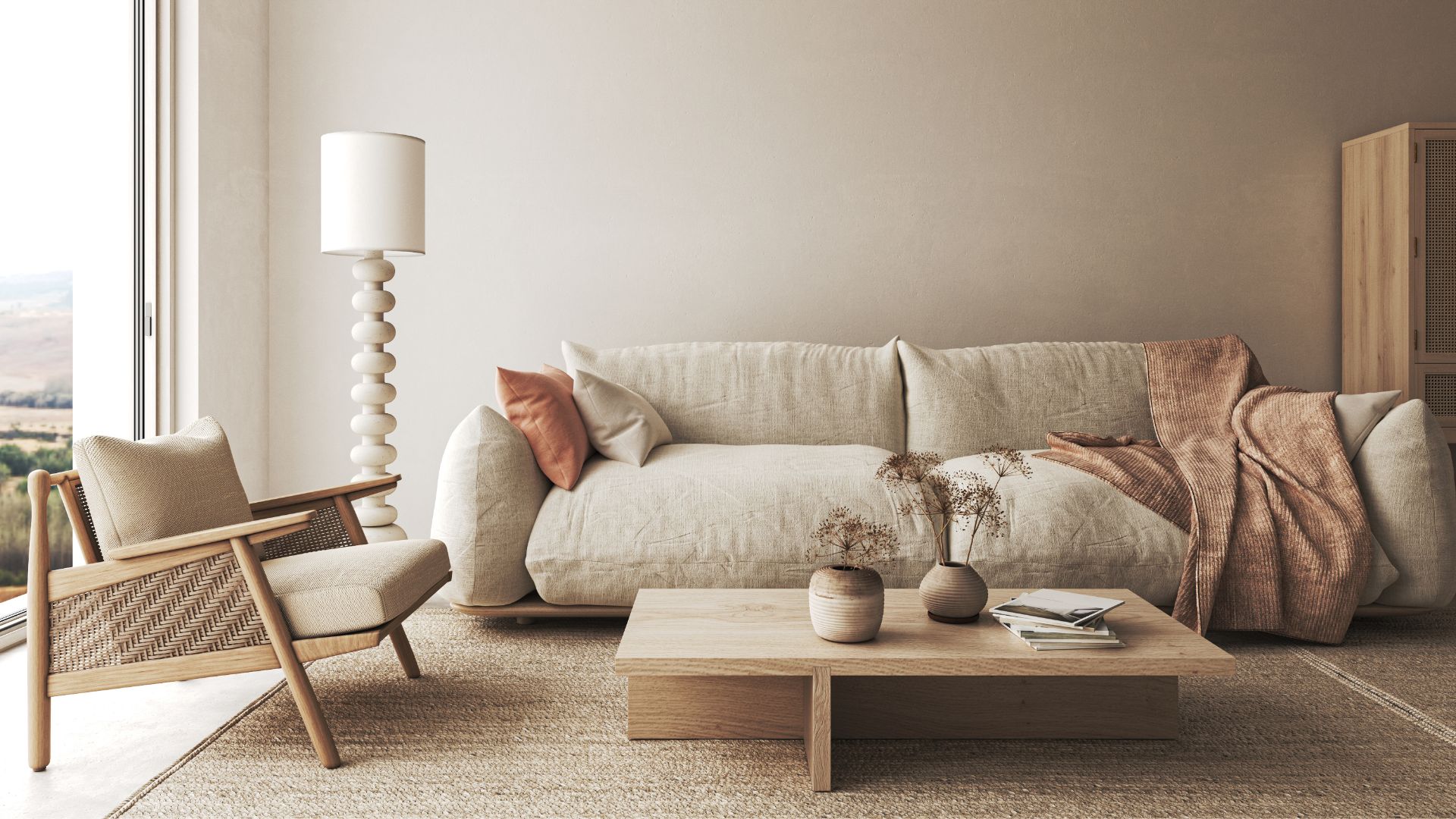Japandi: The Perfect Harmony of Japanese and Scandinavian Design

Japandi is more than just a buzzword in the world of interior design—it’s a movement. Blending the minimalist elegance of Japanese aesthetics with the cozy functionality of Scandinavian style, Japandi has become one of the most popular and enduring trends in home decor. It’s not just about how a space looks; it’s about how it feels, functions, and flows. This design fusion encourages calmness, intentionality, and a deep appreciation for natural beauty.
This rising trend doesn’t feel forced or overly curated. Instead, Japandi interiors naturally feel serene, lived-in, and grounded. Whether you’re designing a compact apartment or a spacious modern home, the Japandi style can elevate your space in a subtle yet transformative way. It’s all about simplicity, purpose, and the perfect balance between two cultures that value understated beauty.
What is Japandi Style?
Japandi is the hybrid design style born from the fusion of Japanese minimalism and Scandinavian functionality. At its core, Japandi celebrates craftsmanship, simplicity, and nature. The clean lines and muted tones of Scandinavian interiors meet the warm, rustic, and often more traditional touches of Japanese decor. The result is a home that feels effortlessly modern and timeless.
This aesthetic goes beyond surface-level decor choices. Japandi is about creating intentional living spaces that promote calmness and clarity. That might mean choosing multi-functional furniture, keeping only what you need and love, or surrounding yourself with textures and elements that reflect the natural world. Japandi isn’t about empty rooms or stark minimalism—it’s about meaningful design.
Both Japanese and Scandinavian styles value function over form—but without compromising beauty. That’s the magic of Japandi. It gives you the freedom to keep things minimal while still injecting character and warmth into your home. Natural wood, matte ceramics, woven textiles, and soft, neutral palettes all play major roles in creating a Japandi-inspired space.
Key Features of Japandi Interiors
One of the most defining features of Japandi interiors is the emphasis on natural materials. Think raw wood, bamboo, cotton, linen, and stone. These textures bring a sense of grounding to any room. this furniture tends to be low-profile with clean, modern lines. You’ll often see pieces made from solid wood, treated to show the grain rather than cover it up.
Color is another crucial element in this design. The palette is typically neutral, often consisting of warm beiges, cool greys, soft whites, and touches of black for contrast. These hues help create an atmosphere of calm and simplicity. Rather than splashy accent colors, this style embraces harmony and balance.
Clutter is the enemy of this design. The aesthetic leans toward the minimalist end of the spectrum, but it doesn’t sacrifice comfort. Storage is smart and intentional. Every object in a Japandi space has a purpose, whether it’s functional or decorative. It’s not about having less just to have less—it’s about making room for what really matters.
Japandi Furniture Essentials

Choosing the right furniture is key to pulling off the Japandi look. You want pieces that are sleek, unfussy, and made from quality materials. Think low-slung sofas, simple wooden coffee tables, modular storage units, and dining tables with clean lines. this furniture is all about form meeting function, so avoid overly decorative or ornate designs.
Another essential trait of this furniture is craftsmanship. Pieces often have a hand-made look, even if they aren’t actually artisanal. This ties into the Japanese principle of “wabi-sabi,” which celebrates the imperfect and the impermanent. The Scandinavian influence adds warmth and softness, usually through upholstery, textiles, or light-colored wood.
Multifunctional furniture is a big win in this interiors. A bench that doubles as storage, or a table that expands, fits perfectly with the mindset of purposeful, flexible living. It’s not about having more—it’s about having better. Every piece should feel like it belongs, both visually and practically.
The Role of Lighting in Japandi Design
Lighting in this interiors is all about creating ambiance. Harsh overhead lights are a no-go. Instead, aim for warm, diffused lighting that enhances the natural tones of your materials. Table lamps, pendant lights, and floor lamps with soft-glow bulbs are ideal. Paper lanterns, reminiscent of Japanese rice lamps, also fit beautifully into this aesthetic.
Layered lighting helps create depth and comfort. Combine ambient lighting with task lighting in key areas like the kitchen or reading nook. this design loves indirect lighting, like wall sconces that reflect light upwards or hidden LED strips under shelves. These small choices go a long way in making a room feel soft and calm.
Natural light is also a cornerstone of the Japandi look. Unobstructed windows, light-filtering curtains, and mirrors that bounce sunlight around the room can make a huge difference. The more daylight you can let in, the better your Japandi space will feel. It’s all about embracing light as a design tool.
Japandi Color Palettes That Work
The Japandi color palette revolves around soothing tones that don’t overpower the senses. Soft neutrals are the foundation—think ivory, stone, sand, and taupe. These colors work together to create a quiet backdrop that lets texture and shape shine.
Earthy shades like muted greens, clay browns, and soft charcoal greys bring the palette to life without disrupting the calm. If you want to add depth, consider using black in small, thoughtful doses—like in a picture frame, chair leg, or ceramic vase. These subtle contrasts can anchor a room without feeling harsh.
it also allows room for warmer tones, like terracotta or dusty rose, especially in textiles like rugs or cushions. These add just enough interest without straying from the overall sense of harmony. It’s not about flashy colors, but about tones that evoke nature and serenity.
Plants and Greenery in Japandi Spaces
While not overloaded with decor, it interiors almost always feature greenery. Plants help bring nature inside and add life to a space. But just like the furniture, the plants you choose should be intentional and well-placed. No jungle vibes here—think a single fiddle leaf fig or a few strategically placed potted succulents.
The key is restraint. it plants are often architectural in shape and displayed in minimalist containers. Ceramic pots, clay vessels, or even hand-woven baskets work well. Bonsai trees, snake plants, and rubber trees are especially fitting for the aesthetic, offering structure and form.
Don’t underestimate the mood-boosting power of plants in this design. Their presence connects us to nature and reinforces the calming principles of both Japanese and Scandinavian philosophies. They aren’t just decor—they’re a part of the home’s natural rhythm.
Japandi in Small Spaces

One of the best things about this is how well it works in small spaces. Because it values minimalism and function, this style naturally lends itself to smaller homes, studios, or city apartments. With its focus on clutter-free living, it helps maximize space without sacrificing style.
Smart storage is essential. Under-bed storage, wall-mounted shelves, and furniture that serves multiple purposes can help keep things tidy. Choosing a cohesive color palette and sticking to natural materials also helps a small space feel more expansive and grounded.
In smaller rooms, every object matters even more. That’s where the Japandi emphasis on intentional design truly shines. A few quality pieces, thoughtfully arranged, can completely transform a tight space into a peaceful retreat.
FAQs
What exactly is Japandi interior design?
Japandi is a fusion of Japanese minimalism and Scandinavian functionality, resulting in a clean, calming, and purposeful interior style. It focuses on natural materials, neutral colors, and intentional living.
Can I mix Japandi with other design styles?
Yes, but be selective. Japandi already blends two strong styles, so it’s best to add only subtle touches from other aesthetics—like a boho throw or a rustic farmhouse accent—without overpowering the core look.
What colors are best for a Japandi room?
Stick to soft neutrals like beige, grey, white, and warm wood tones. Earthy greens, muted black, and clay tones also work well as accents. Avoid bright or neon colors, which clash with it’s calming vibe.
Is Japandi just a trend?
While it’s currently popular, this is rooted in timeless design philosophies. Its focus on quality, function, and simplicity means it’s likely to stay relevant for years to come.
Do I need to renovate my entire home to achieve the Japandi look?
Not at all. You can start small—maybe with a bedroom makeover or by decluttering and adding natural textures to your living room. Gradually introduce it principles, and the transformation will unfold naturally.
Conclusion
Japandi is more than a design trend—it’s a lifestyle shift. It encourages slowing down, simplifying, and creating spaces that bring joy and tranquility. By blending the mindful elegance of Japanese interiors with the cozy, livable charm of Scandinavian design, Japandi offers the best of both worlds. Whether you’re redecorating an entire home or just updating one room, embracing Japandi can help you create a space that feels just right.





